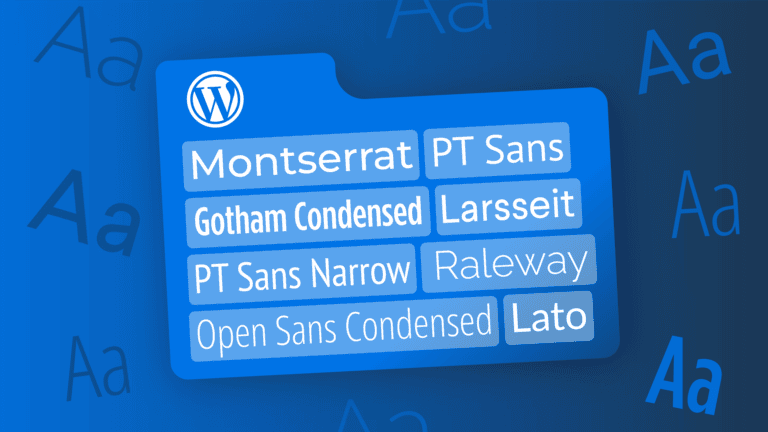Choosing the Right Fit: Squarespace vs. WordPress
If you’re running a business, starting a blog, or simply want to create a professional-looking website, you’ve probably wondered if you should use WordPress or Squarespace to build your site.
Both platforms have gained quite a following, and it’s easy to see why. WordPress powers an impressive 43.5% of all websites on the internet. Squarespace, while not as widespread, has still captured 3.0% of the market.
But what sets them apart, and more importantly, which one is right for you?
We’re here to help you figure it all out! In this article, we’ll break down the key aspects of both platforms, including user experience, customization options, advanced features, SEO tools, scalability, support, and pricing.
Full disclosure: As creators of a WordPress theme and plugin, we know that side of things inside out. But don’t worry — our goal is to help you make the best choice for your specific needs, whether that ends up being WordPress or Squarespace!
P.S. In this article, we’re talking about WordPress.org, the self-hosted version where you get full control, and not WordPress.com, which is a hosted service. Still confused or want to learn more? WordPress.com has a great guide on the differences between .com and .org.
The bottom line is that while WordPress.com and Squarespace share some similarities as hosted platforms, WordPress.org offers a lot more flexibility and customization for those looking to build a website.
What is WordPress?
WordPress.org is a self-hosted, open-source content management system (CMS). Unlike some all-in-one website builders, WordPress allows you to choose your own hosting provider. Don’t let that intimidate you, though! Most modern hosting platforms have made WordPress installation super easy, often requiring just a single click.
One of WordPress’s greatest strengths is its open-source nature. This means that a global community of developers is constantly improving and expanding its capabilities. The result? An ever-growing ecosystem of themes and plugins that can transform your site into virtually anything you can imagine.
Who should choose WordPress?
WordPress is for anyone who wants a website that’s as unique as they are. It’s perfect for those who appreciate a balance of user-friendliness and advanced capabilities and don’t mind a bit of a learning curve in exchange for greater control over their web presence.
Now, it’s time to see if you recognize yourself in these WordPress-friendly profiles! If so, here’s what we think you’ll love about WordPress:
- Bloggers and content creators: WordPress started as a blogging platform, so its content management features are understandably strong. You’ll enjoy the user-friendly block editor, extensive categorization and tagging options, and customizable themes designed specifically for blogs. Plus, the advanced user management and content visibility controls allow you to grow your audience while maintaining control over your content.
- Business owners and entrepreneurs: WordPress works well for businesses of all sizes. You can create professional websites, set up online stores with WooCommerce, or even build job boards. As your business grows, WordPress grows with you. You can easily add new features, handle more traffic, and set up networks of sites if needed.
- Developers: If you like to code, WordPress gives you a lot to work with. Its plugin system lets you extend and modify how WordPress works, with thousands of hooks and filters at your disposal. You can create custom plugins to add new features or change existing ones. And remember how we said WordPress’ open-source nature is a strong suit? Well, here’s another reason why: You’re free to use WordPress for any kind of project, commercial or not, without licensing fees, making it a flexible choice for various development needs.
What is Squarespace?
Squarespace is a hosted website builder that’s gained quite a following, especially among small businesses and creatives. One of its biggest selling points is its user-friendly setup. All you have to do is sign up, and you’ll be ready to start building your site right away.
Now, unlike WordPress, Squarespace is a closed-source platform. This means only Squarespace employees can modify the underlying code. As a result, you’re limited to the features and designs Squarespace offers. While there’s a good range of templates and built-in features, you can’t add functionality through third-party plugins like you can with WordPress.
But don’t let that worry you just yet! This closed nature has its advantages, including enhanced security and regular, platform-wide updates. Plus, everything you need — from hosting to SSL certificates — is included in one package. In the next sections, we’ll dive deeper into how Squarespace compares to WordPress in various aspects.
Who should choose Squarespace?
Do you value simplicity and design over extensive customization? Then, Squarespace is for you! Take a look at these Squarespace-friendly profiles and see if you spot yourself:
- Visual artists and photographers: With high-quality, image-centric templates and advanced gallery options, Squarespace is a dream for showcasing visual work. You’ll appreciate the built-in image editor, lightbox presentation, and the ability to control focal points for perfect image cropping.
- Non-technical users: If you’re new to website design, you’ll love Squarespace’s intuitive drag-and-drop interface and pre-designed templates. The guided setup process and no-code editing capabilities make it easy to create a professional-looking site without technical know-how.
- Solopreneurs: Squarespace’s all-in-one platform includes hosting, design, and e-commerce capabilities. You’ll benefit from integrated business tools like scheduling and invoicing, plus built-in marketing features, including SEO and social media integration.
Key differences between Squarespace and WordPress
| Feature | WordPress | Squarespace |
|---|---|---|
| Ease of use | More flexible but has a learning curve. | Beginner-friendly. |
| Customization | Highly customizable with thousands of themes and plugins. | Limited to the available template options. |
| Advanced features | Over 59,000 plugins available for extending core functionality. | Offers built-in features, which, while convenient, are limited. |
| SEO and marketing | Powerful SEO plugins available for in-depth optimization. | Built-in basic SEO tools, covering essentials for most users. |
| Performance | Performance varies based on hosting and plugins; highly optimizable for speed. | Reliable performance with built-in hosting, though customization options are limited. |
| Support | Large community and extensive resources; support varies by theme and plugin. | Smaller community; 24/7 live chat and email assistance by Squarespace. |
| Price | Variable costs, from free to premium themes, plugins, and hosting fees. | Simple, all-inclusive monthly plans with hosting included. |
Comparing platforms: WordPress vs. Squarespace
Now that you’ve got a general idea of what WordPress and Squarespace offer, let’s break down each aspect of these platforms in detail so you know what you’re signing up for.
1. User experience
WordPress
If you asked us what we love most about WordPress, we’d say it’s how it allows you to take full control of your site. You have the power to customize pretty much everything, from your website’s look to its functionality. While WordPress is known and beloved for its flexibility and customization, it does come with a learning curve.
Unlike drag-and-drop platforms, WordPress requires users to navigate themes, plugins, and sometimes code to create a tailored site. While this may feel overwhelming at first, it also means nearly limitless possibilities as you get comfortable.
When you first log into WordPress, you’ll be greeted by the dashboard. This is your command center, where you can access all aspects of your site. The left-side menu is your main navigation tool, providing access to posts, pages, media, comments, appearance settings, plugins, and more.
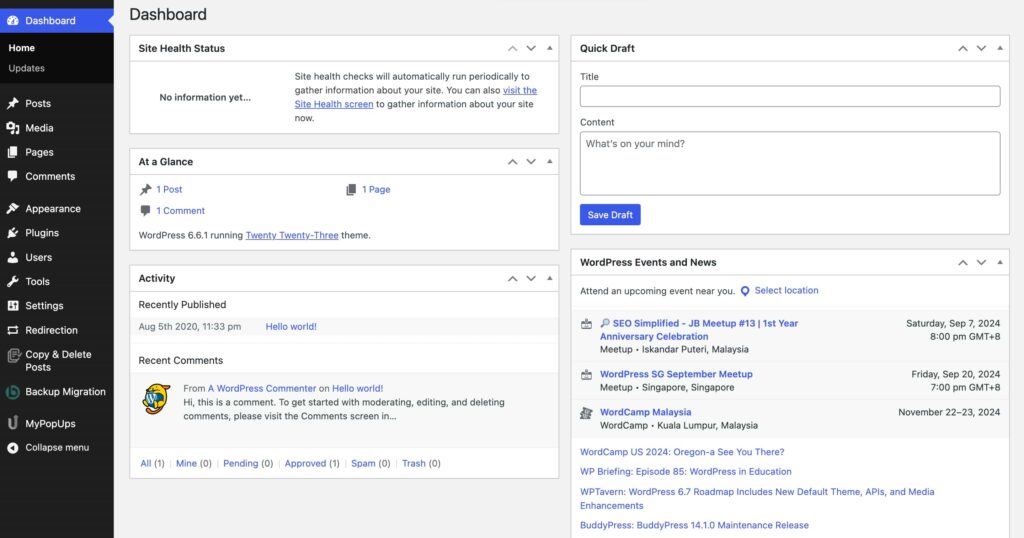
At first glance, the dashboard might seem scary with its numerous options and menus. But don’t worry — as you become more familiar with WordPress, you’ll appreciate having all these tools at your fingertips. The dashboard is also customizable, allowing you to add or remove widgets to suit your needs.
The core of WordPress is its CMS, which is designed for posting regular content. This means that out of the box, WordPress doesn’t have a drag-and-drop editor like some website builders. Instead, it uses a block editor called Gutenberg. Gutenberg allows you to add various elements (or ‘blocks’) to your pages and posts. These can include text, images, videos, buttons, and more.
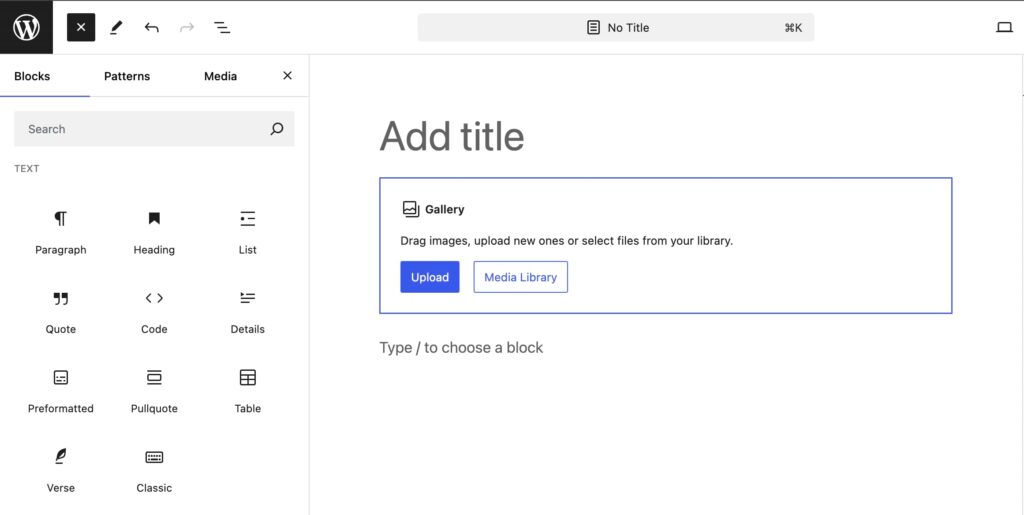
One of the best things about WordPress, even if it seems like a big decision initially, is you get to choose your own hosting and domain. Instead of being tied to a single provider, you can select dedicated hosting services, like Liquid Web, and register domains through providers such as Namecheap or GoDaddy. This freedom allows you to select plans based on your specific needs for website speed, security, and scalability.
As you understand the basics, WordPress becomes a powerful tool that can adapt to your needs, allowing you to create a site that’s truly unique. For those willing to invest a little time in learning, WordPress offers a highly rewarding, customizable experience.
Squarespace
With Squarespace, you don’t have to find separate hosting or register a domain elsewhere, so getting started is straightforward.
Squarespace offers an intuitive drag-and-drop interface. The Fluid Engine editor allows you to place elements precisely where you want them on your pages, offering a visual editing experience that’s both powerful and user-friendly. This approach is similar to what you’d experience when using WordPress with block builders like Kadence Blocks.
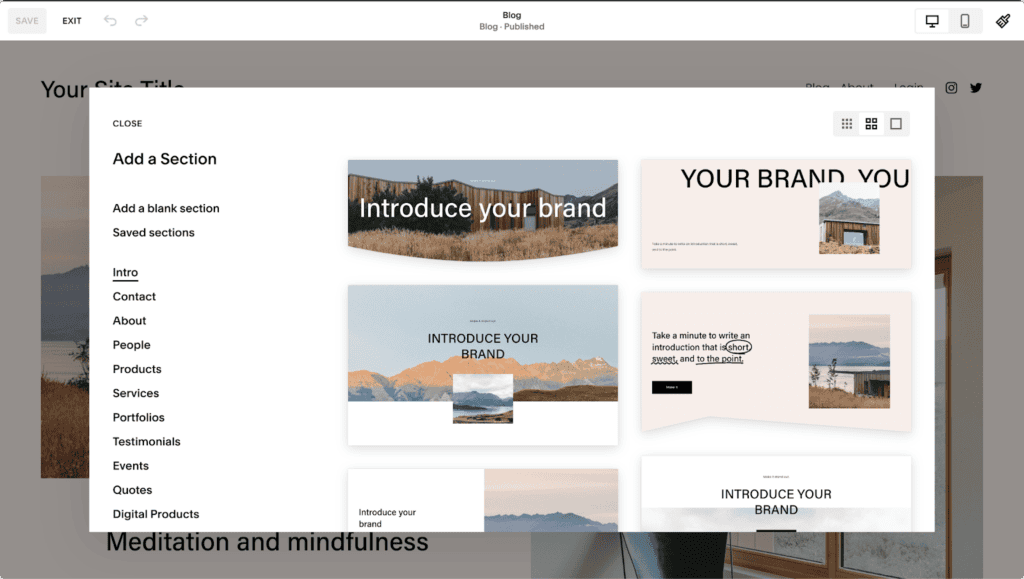
When you first start with Squarespace, you’re greeted with a helpful onboarding process. The left side of the screen presents a list of every part of your site, while the right side offers a pop-up that guides you through initial customization steps. This walkthrough covers everything from setting your site title and logo to choosing fonts and colors, which is particularly useful for beginners.
Squarespace’s dashboard is designed with simplicity in mind. Unlike some platforms where the dashboard grows more complex as you add features, Squarespace remains relatively consistent. It’s fast, intuitive, and doesn’t require extensive technical knowledge to navigate. Users can edit and change most aspects of their site from a single interface without constant page reloads.
While Squarespace offers a good balance of design flexibility and ease of use, it doesn’t match the extensive customization options that WordPress provides. Squarespace allows you to adjust layouts, add or remove elements, and tweak spacing and formatting, which is sufficient for many users. However, if you want unlimited design possibilities and complete control over your site’s functionality, you’ll find that with WordPress.
Another important consideration is that with Squarespace, you don’t have full ownership of your site’s infrastructure. Your content is yours, but the code, templates, and hosting setup belong to Squarespace. So, if you decide to switch from Squarespace to a different platform later, you’ll likely have to spend some time rebuilding parts of your site.
Winner: WordPress
If you want a quick and easy way to build a basic site, Squarespace is a decent choice. But if you’re looking for maximum flexibility and control, WordPress is hard to beat. It might take a bit longer to learn, but the payoff is huge. After all, there’s a reason why WordPress powers nearly half of all websites across the world — it lets you create pretty much any kind of site you can imagine.
2. Customization and design
WordPress
WordPress offers extensive options to create a unique website, and themes are the starting point.
While WordPress has a few default themes, we recommend exploring beyond these. The official WordPress repository hosts thousands of free themes, and you’ll be amazed at the variety. Can’t find exactly what you’re looking for? There are also numerous third-party marketplaces offering premium themes with even more features.

Once you’ve chosen a theme, it’s time to make it your own. WordPress’s built-in Customizer is a user-friendly tool that lets you tweak various aspects of your theme, including colors, fonts, and layout options, without touching code.
For content creation and layout design, WordPress uses the Gutenberg block editor we mentioned in the previous section. We’re fans of this editor because it allows you to build pages using a variety of blocks. You can drag and drop a wide range of elements, from simple paragraphs and images to more complex components like buttons, columns, and embeds.
However, while these blocks are a great starting point and offer flexibility for many users, we find they can be somewhat limiting for more complex designs. That’s why plugins like Kadence Blocks are so valuable. Kadence Blocks enhances the native Gutenberg editor by adding more design features and pre-made sections. You don’t need to know any code to use it, which makes it great for creating a look you love without dealing with the technical details.
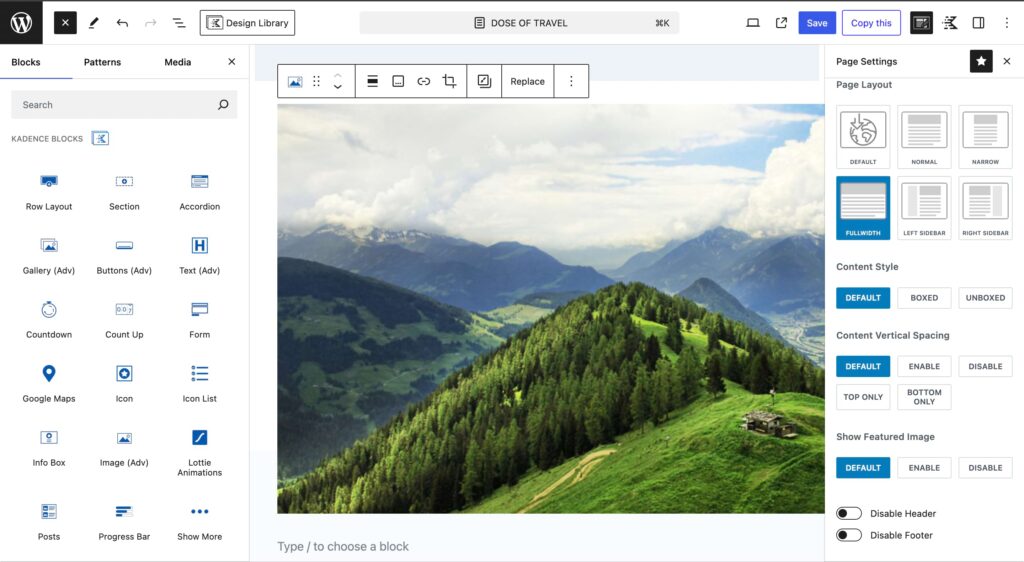
For those of you who are comfortable with code, WordPress offers full access to the core files. You can work directly with HTML, CSS, PHP, and JavaScript to customize every aspect of your site, from its appearance to functionality.
This flexibility and ease of use haven’t gone unnoticed by users. One G2 reviewer shared their experience: “I really like the customization control and the liberty it gives me to fine-tune my website as per my taste and needs. It opens up endless possibilities about the things that I can do for my business and customers.”
Squarespace
When you sign up to Squarespace, you get access to a collection of professionally designed templates. These look great on all devices, from phones to desktop computers, without you having to do any extra work. Currently, there are over 200 templates available, which is limited compared to WordPress’s thousands of themes. But hey, that could be a blessing in disguise if you suffer from chronic decision fatigue!

Squarespace’s page builder, while not as flexible as some WordPress page builders, is intuitive and user-friendly. You can add various content blocks to build your pages, similar to WordPress’s Gutenberg editor. Just keep in mind that you won’t have as much control over things like positioning — it’s more about choosing titles, captions, and color palettes. This can make it challenging to create a truly unique design, especially if you have specific needs that don’t quite fit a ready-made template.
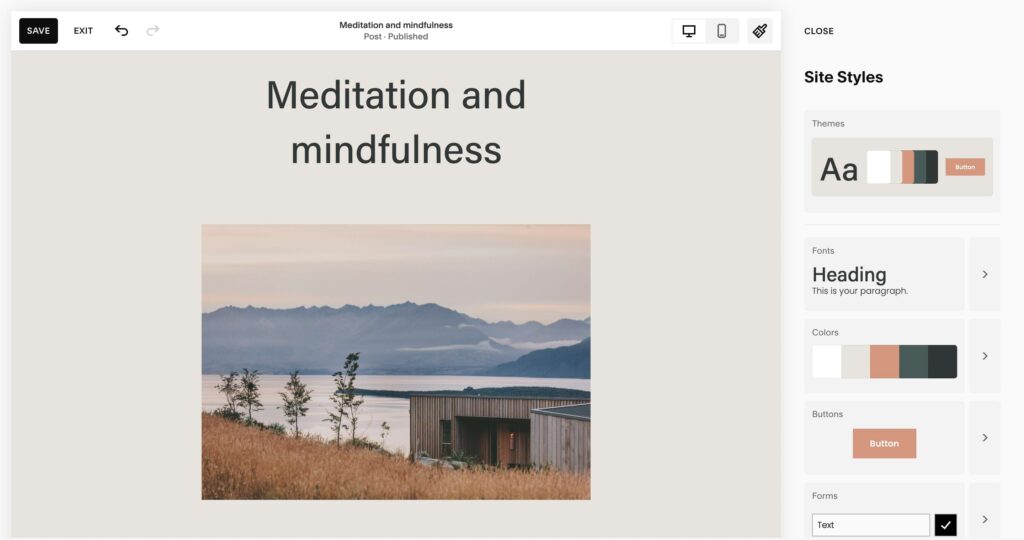
For those with some coding knowledge, Squarespace does offer more advanced customization options through custom CSS and Developer Mode. However, these features aren’t as extensive as what WordPress offers and aren’t necessary or accessible for most users.
Nonetheless, we appreciate that Squarespace’s approach eliminates the need for separate plugins for features like e-commerce, analytics, or SEO. These are all integrated into the platform, which is perfect for users who are new to website building.
Winner: WordPress
From a customization standpoint, WordPress is far superior, hands down. Its extensive library of plugins and themes provides nearly limitless options. You can create a fully customized site without any coding knowledge, but the option to code is available if needed. Squarespace might be simpler initially, but WordPress offers more flexibility for long-term site growth.
3. Advanced features
WordPress
WordPress is incredibly versatile and capable of handling everything from simple blogs to complex e-commerce sites.
The plugin ecosystem is WordPress’s standout feature. With over 59,000 free plugins in the official repository, you can add virtually any functionality to your site. Custom blocks? Dynamic content? Specialized forms? WordPress has plugins for all these and more to help you tailor your site to your exact needs.
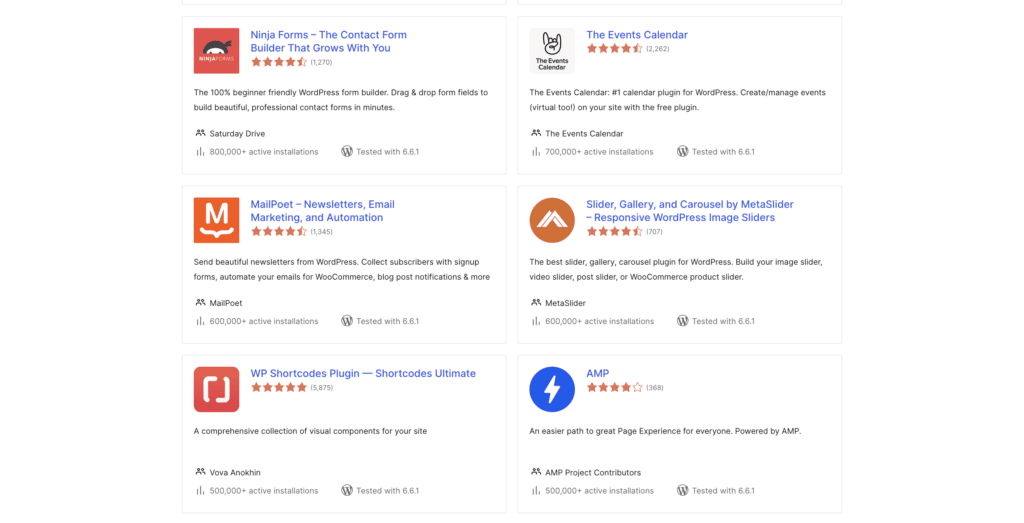
For those venturing into online sales, WordPress doesn’t disappoint. WooCommerce, the platform’s most popular e-commerce plugin, transforms your site into a highly customizable online store. It’s also scalable, allowing you to start small and expand as your business grows.
There are tons of ways to make money with WordPress, too. You can easily display ads, include affiliate links, offer subscription-based content through Patreon, or even set up a membership site with MemberPress.
Widgets are another key feature of WordPress, allowing you to display various elements in designated areas of your site. From recent posts in a sidebar to real-time SEO scores as you write, widgets add functionality and customization options to both the front-end and back-end of your site.
Squarespace
Squarespace takes a different approach to features and functionality. Instead of relying on plugins, it offers a suite of built-in tools designed to give you a ready-to-go experience.
The platform’s Extensions Marketplace adds extra functionalities, especially for e-commerce, shipping, accounting, and marketing. While it’s not as extensive as WordPress’s plugin library, it’s enough to cover most users’ needs.
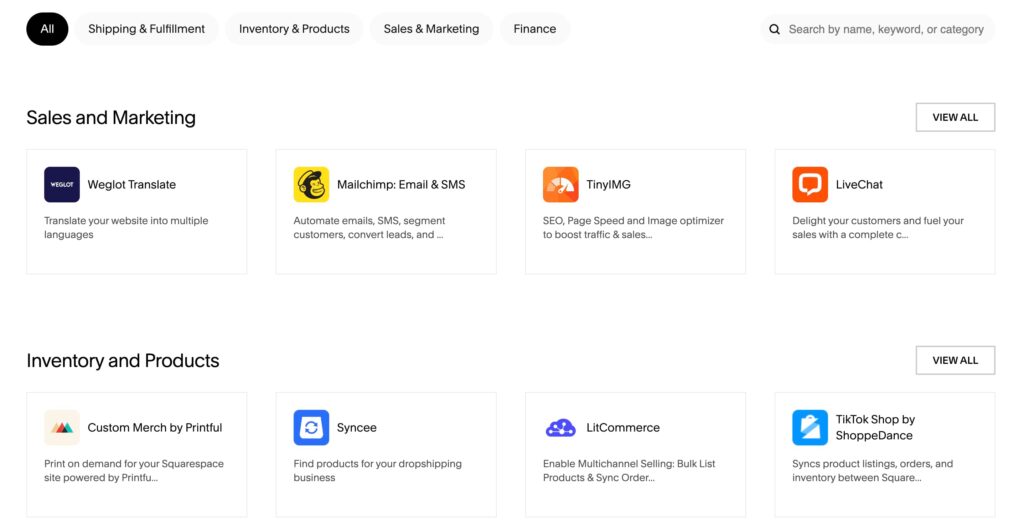
When it comes to e-commerce, Squarespace offers user-friendly features that are great for getting an online store up and running quickly. However, if you’re looking for highly specialized e-commerce features, you might find the options a bit limited compared to what’s possible with WordPress and WooCommerce.
For monetization, Squarespace allows you to add a paywall to charge for content access. You can also promote and sell digital products, giving you some flexibility in generating revenue.
However, the general theme here is that while Squarespace mostly matches up to WordPress’ offerings, it’s not quite there — at least not yet. A Reddit user summed it up nicely: “If you just need the basics, Squarespace will be easier. If you need scalability or flexibility, from directory,
e-commerce, and just basically everything for your business, then WordPress is the way to go.”
That’s a spot-on take. Squarespace is great for many common needs, but if your site starts to grow and you want to do more complex stuff, you might feel a bit boxed in. WordPress, on the other hand, is super flexible. It’s like a blank canvas — you can keep adding to it and changing it as your needs grow.
Winner: WordPress
While Squarespace offers a solid set of built-in features, WordPress has the edge here. Its vast plugin ecosystem provides unparalleled flexibility to add advanced features and functionality to your site. If you’re looking for a platform that can grow and adapt to your needs, WordPress is undoubtedly the better choice.
4. SEO and marketing
WordPress
WordPress’s structure is inherently SEO-friendly, but it’s the plugins that really take things to the next level. Popular options like Yoast or Rank Math give you granular control over every aspect of your site’s SEO, from meta descriptions to XML sitemaps. We love how they provide real-time feedback as you write so you can optimize your content on the spot.
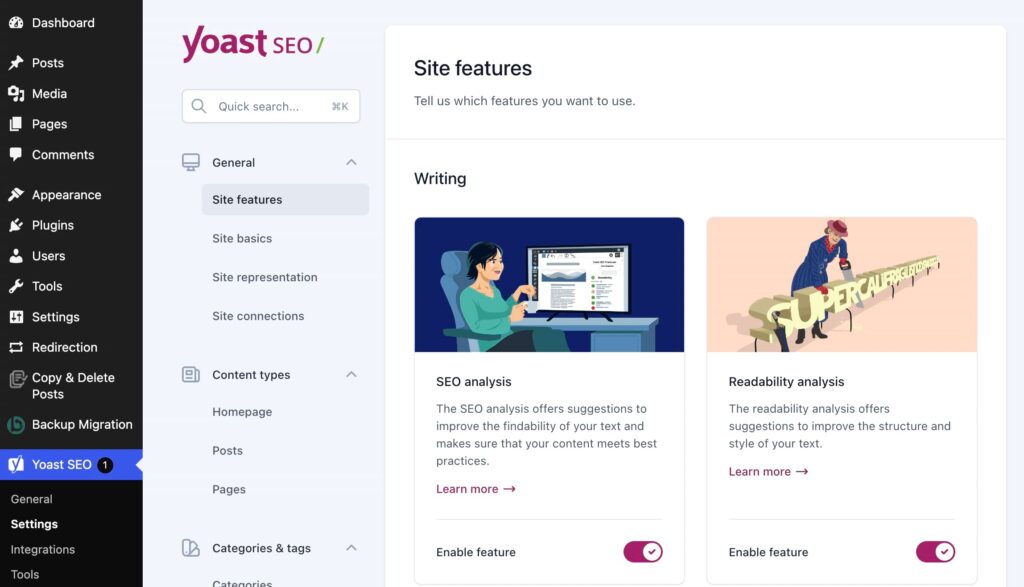
Content marketing with WordPress is also highly effective. You can create custom post types, integrate with content collaboration platforms, and manage your content strategy efficiently. It’s essentially a full marketing toolkit built right into your website.
For email marketing, WordPress integrates smoothly with popular services like Mailchimp. This flexibility gives you plenty of options, allowing you to select the best tool for your specific needs.
WordPress’ approach to SEO and marketing has its pros and cons. On one hand, you have the freedom to choose the best tool for your specific needs. On the other, it means another integration to manage and potentially another cost to factor in. In our view, though, WordPress is tough to beat for serious marketers who want full control over their strategy.
Squarespace
Squarespace includes basic SEO features by default, which are user-friendly and accessible for beginners. You can easily optimize page titles, meta descriptions, and URLs without needing to install additional plugins.
However, advanced users might find these built-in SEO tools somewhat limiting. While they cover the essentials, they don’t offer the depth of customization that specialized SEO plugins provide for WordPress. For instance, WordPress users can customize XML sitemaps, which is particularly useful for larger websites, and have more granular control over page speed optimization through various plugins and customizations. It’s also worth noting that adding third-party SEO tools isn’t an option with Squarespace, which could be a drawback for those who want more control over their SEO strategy.
For content marketing, Squarespace offers basic blogging tools that cover the essentials, similar to WordPress. You can create and categorize posts, schedule content, and manage authors.
These features are sufficient for many users, but they lack some of the advanced functionalities that dedicated bloggers or content marketers might be looking for. For example, its collection system (which organizes content like blog posts, products, or events) allows for some customization through custom fields, but is no match for WordPress’s custom post types and taxonomies.
One aspect we do appreciate about Squarespace is its built-in email marketing tool.
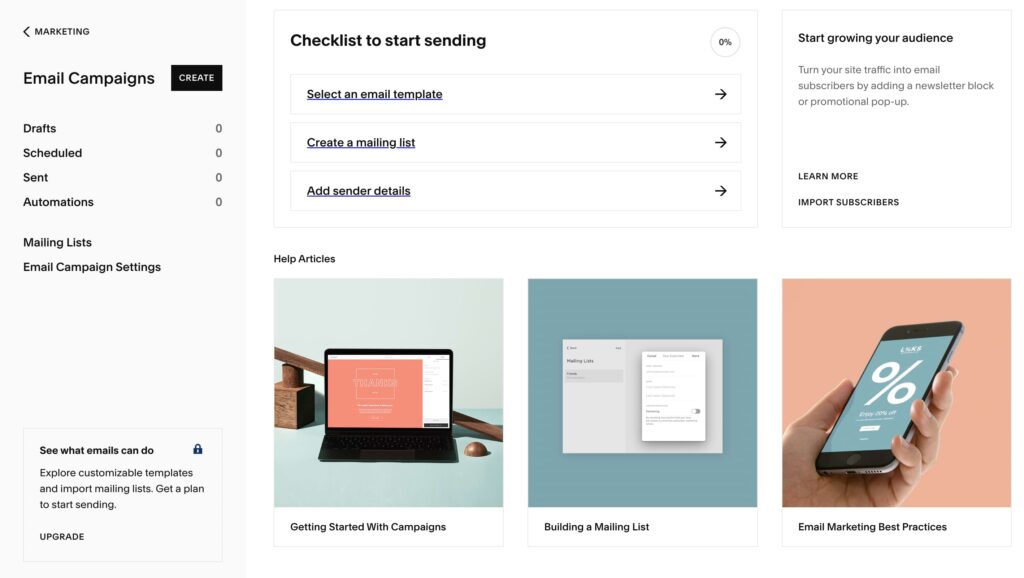
It’s useful for managing mailing lists and sending newsletters, all from within the same platform you use to manage your website. This integration can save a lot of time, especially for small businesses or solo entrepreneurs who want to keep their marketing tools streamlined.
Winner: WordPress
For marketers and businesses looking to grow their online presence, WordPress is the superior choice. Its features, extensive customization options, and scalability make it ideal for implementing comprehensive, sophisticated SEO and marketing strategies. While it may require more setup and management, the payoff in terms of marketing potential and SEO control is huge.
5. Scalability and performance
WordPress
WordPress can handle just about any website size you can imagine. It powers everything from small personal blogs to some of the biggest sites on the web. You might even recognize a few, like NASA, The White House, and The New York Times Company.
The great thing about WordPress is that it can grow with you. As your site grows, you can add more features and handle more traffic by picking the right plugins and hosting.
This flexibility extends to performance, as well. With WordPress, you’re in control. Your site’s speed depends on your hosting choice and how you optimize it. While this means you have full control, it also requires you to pay attention to these factors.

The same principle applies to security. WordPress offers solid protection, but you need to be proactive. Plugins like Solid Security, Wordfence, and Sucuri can keep your site secure, offering peace of mind as your online presence expands.
Squarespace
Squarespace is great for small to medium-sized sites, but it might struggle if you’re planning to go big. The platform isn’t as flexible as WordPress for handling high traffic or complex site structures.
That said, Squarespace does offer decent performance out of the box. Your site will likely be fast initially, but as it gets more complex, you’ll notice some slowdowns. In fact, some users have reported challenges with site speed, particularly those with image-heavy sites or multiple integrations.
There have also been complaints about poor performance scores on speed testing tools, with users finding it difficult to optimize their sites beyond a certain point. Many have had to make tough choices, like removing certain features, just to maintain acceptable load times.
While performance can be a bit of a headache as your site grows, Squarespace tries to make up for it in other areas.

Security, for instance, is a strong point. As a closed-source platform, Squarespace handles most of the security aspects for you. They provide built-in SSL certificates for all Squarespace domains and connected third-party domains, ensuring a basic level of security for all sites. The flip side of this is you have limited control over how security is implemented, so it’s a case of convenience versus control.
Winner: WordPress
If you’re looking for a platform that can grow with your goals and give you control over performance, WordPress is the right choice. It puts you in charge of everything from hosting to plugin choices, allowing you to fine-tune your site’s performance and security as you see fit.
6. Support and knowledge base
WordPress
WordPress has a massive user community, and that’s a big deal when you need support. There are numerous forums, tutorials, and documentation. No matter what problem you’re facing, chances are someone else has faced it, too, and already found a solution.
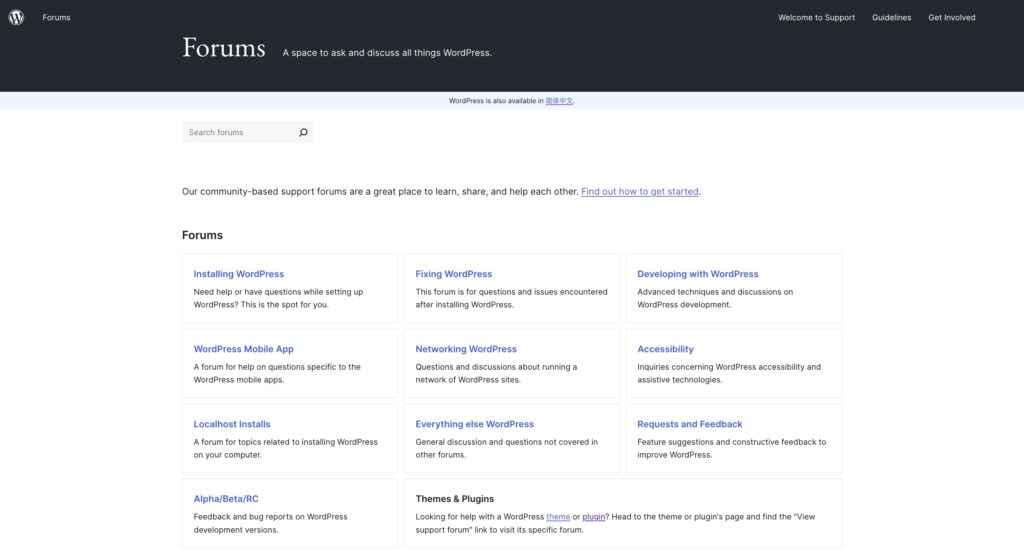
However, it’s worth noting that WordPress doesn’t offer direct support. Instead, you’ll get help from your hosting provider and the developers of your themes and plugins. For instance, if you’re using Kadence Blocks, you can join our Facebook community group and get direct feedback from other users!
This might sound a bit intimidating at first, but don’t worry — the WordPress community is incredibly helpful and welcoming.
Squarespace
Squarespace offers 24/7 customer support via live chat and email. If you prefer having someone to talk to directly when you have an issue, this could be a major plus for you.
Fair warning, though: many users have reported challenges with Squarespace’s customer service, citing issues such as delayed responses and difficulty resolving complex problems. One Trustpilot review said, “Maybe the worst customer service experience of my life. It’s impossible to speak to anyone ever. The live chat is never available. (Demand too high). So you can email them and they never respond. Basically, there is no customer service at all!”
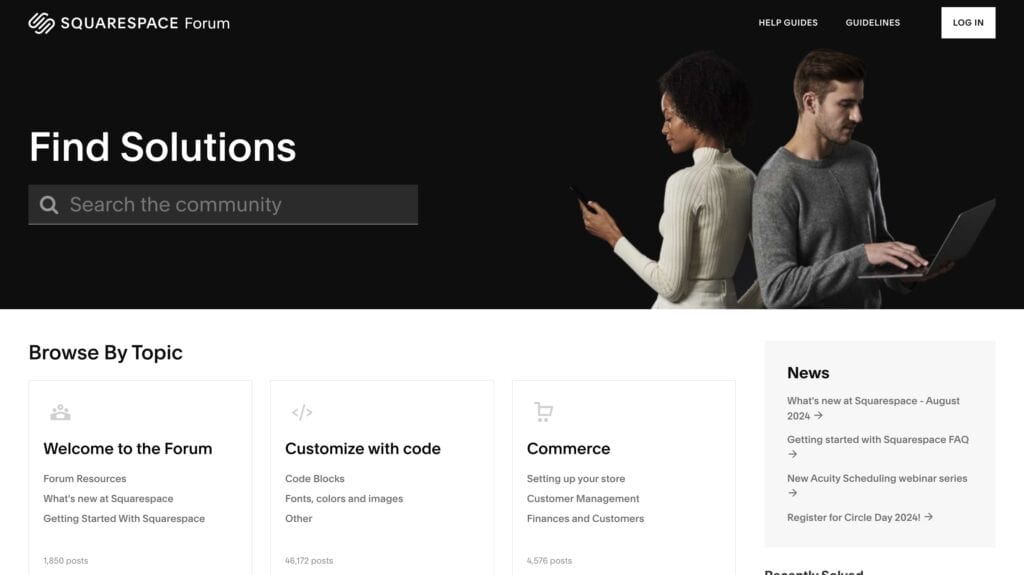
Squarespace also has a help center and community forum, similar to WordPress, but it’s significantly smaller. You can still find solutions and tips there, which is helpful, especially if you’re ever struggling to get a response from the official support team.
Winner: Tie
If you like to dig in and find solutions yourself, you won’t even miss the fact that WordPress doesn’t have direct support. Plus, the wealth of resources available is genuinely impressive.
On the other hand, if you prefer real-life, immediate assistance, Squarespace’s customer support would be better for you. However, while Squarespace promises round-the-clock support, keep in mind that user reviews suggest you might need to rely more on community resources and your own problem-solving skills than expected.
7. Price
WordPress
WordPress itself is free, but there are some additional costs to consider. You’ll need to pay separately for hosting, a domain name, and potentially for premium themes and plugins.
The good news is you can tailor these costs to your budget and needs. Want to start small? Go for basic hosting and free themes. Ready to invest more? Upgrade to premium options as your site grows.
Squarespace
Squarespace offers all-inclusive pricing plans. These cover your hosting, domain, and templates all in one package. It’s easy to budget for, which many users appreciate. Their plans start at $16 per month (billed annually) and go up to $49 per month for more advanced features. You can check out their full pricing details for more information.
Winner: Tie
If you want a clear, predictable cost from the start, Squarespace might be your best bet. But if you’re looking for more flexibility and don’t mind managing separate costs, WordPress could save you money in the long run. It really depends on your specific needs and how much time you’re willing to invest in managing your site.
Switching from Squarespace to WordPress
TL;DR: While Squarespace offers convenience, WordPress offers potential. It might take a bit more time to get used to, but once you do, the options for your website are endless. For those looking to build a powerful online presence that can adapt and evolve over time, WordPress is the clear winner.
Considering a switch from Squarespace to WordPress? It’s a smart move. WordPress offers all the features you’ve come to love in Squarespace, plus a whole lot more. You’ll gain access to unparalleled functionality, greater scalability, and the freedom to truly make your website your own.
The good news? Transitioning is quite straightforward! Here’s what you need to do:
- Start by finding a reliable WordPress host and installing WordPress.
- Use Squarespace’s handy ‘exporter’ tool to save your pages, blog posts, gallery items, text, images, and most other elements.
- Once you’ve got your content, head over to WordPress and use the Tools > Import tab to bring everything across.
For a detailed guide on importing your content from Squarespace, check out WordPress.com’s support article on the topic. With a bit of planning, you’ll be up and running on your new, more powerful WordPress site in no time.
Kadence Blocks: The game-changer for WordPress website builders
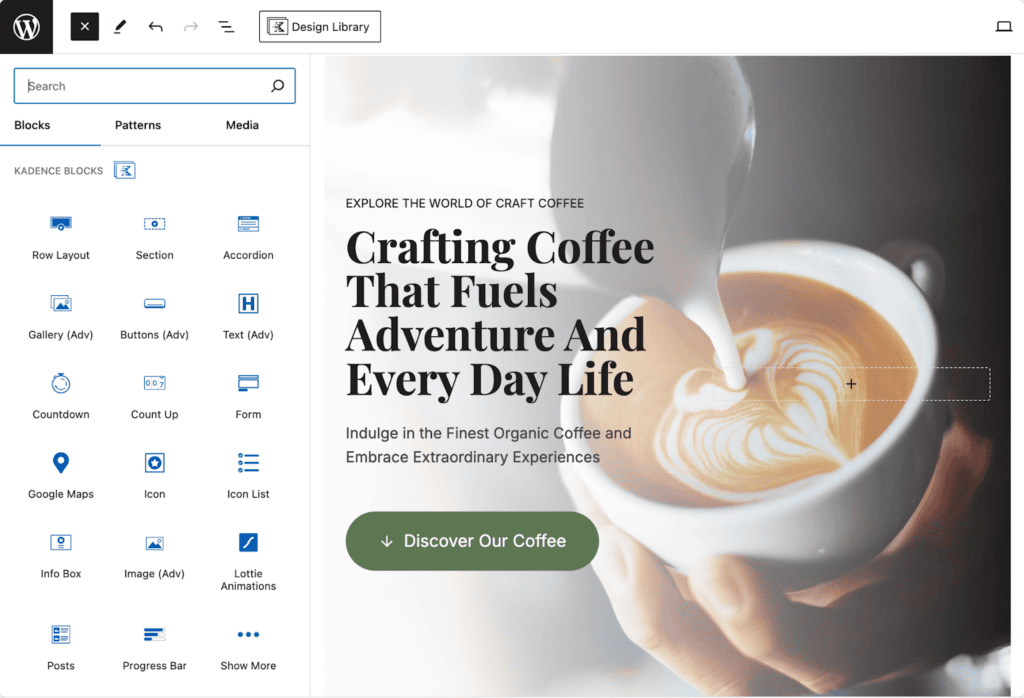
Even if you’ve spent hours reading reviews from every dark corner of the web, choosing between WordPress and Squarespace can still feel like a tough decision. WordPress’ learning curve might seem daunting, while Squarespace feels limiting. Luckily, Kadence Blocks offers a solution that combines the best features of both platforms.
This plugin offers a simpler way to customize your site without compromising on flexibility. With Kadence Blocks, you get WordPress’s power alongside the user-friendliness that makes Squarespace so appealing.
Kadence Blocks provides an intuitive interface within the Gutenberg editor in WordPress, along with advanced design and functionality features that can grow with your needs. Here’s how it fares in some of the main categories we’ve covered:
- Ease of use: Kadence Blocks simplifies the design process, making it accessible even for those with limited technical skills. When combined with the Kadence Theme and its starter templates, you can whip up fast and beautiful websites in minutes. The intuitive drag-and-drop interface and pre-built design library let you create visually stunning sites effortlessly. Additionally, Kadence’s AI starter templates help users generate professional-looking designs quickly, giving you a head start when building your WordPress site.

- Customization and control: Despite its ease of use, Kadence Blocks doesn’t skimp on customization options. It offers extensive possibilities to tailor your site to your specific needs and brand identity. You can build unique layouts and control all design settings, giving you the flexibility to create exactly what you envision.
- Performance and SEO: Kadence Blocks contributes significantly to website speed, which is essential for performance, user experience, and SEO. It achieves this by loading CSS or Javascript only when needed, and only for the blocks used on a specific page. This approach minimizes unnecessary code and improves page load times.
- Advanced features: For users seeking more advanced capabilities, Kadence Blocks Pro offers additional features such as custom Pro blocks, custom fonts, and dynamic content. These tools provide even more options for creating sophisticated, high-performing websites.
Websites that thrive with Kadence Blocks on WordPress

Let’s look at a real-world example of Kadence Blocks in action. Posh Pennies, a vibrant blog focused on lifestyle, home decor, and DIY projects, has become the go-to source for readers looking for inspiration and budget-friendly tips to create beautiful spaces.
What sets Posh Pennies apart is more than just its clever DIY tutorials and elegant decorating ideas — it’s the presentation. The site’s attention to detail and aesthetics keep visitors engaged and coming back for more.

So, what’s their secret? They’re using WordPress with the Kadence Theme and Kadence Blocks. This combination has given them the flexibility to create a blog that’s fantastic to look at but also quick to load and easy to use. And you know what? It’s working. Really well, in fact. Posh Pennies has been steadily growing its traffic, audience, and influence. It just goes to show what the right tools can do for a blog.
Katy Boykin, Product Marketing Manager at Kadence WP, says:
“Posh Pennies is a great example of how Kadence can help bloggers and businesses create a professional-looking site without needing to be tech experts. We’re all about making WordPress powerful and easy to use at the same time.”
Choose WordPress and Kadence for all your website-building needs
WordPress is the go-to choice for website building, and for good reason. It’s incredibly flexible and lets you customize pretty much everything. That’s why it’s the most popular content management system out there. Plus, with thousands of plugins available, you can add almost any feature you can think of to your site.
Kadence Blocks takes this flexibility even further. Working right inside WordPress’s Gutenberg editor, it makes creating complex layouts and designs super easy without needing any coding skills. It’s genuinely as close as you can get to having a professional designer at your fingertips.
And if you’re wondering about ease of use, rest assured, using WordPress with Kadence Blocks solves many of the technical hurdles that sometimes push people towards simpler options like Squarespace. You get all the power of WordPress, but with the user-friendliness of drag-and-drop builders. As an added bonus, Kadence ensures your site loads quickly and looks great on all devices.
Ready to elevate your website? Take the next step and explore Kadence Blocks today! Whether you’re creating a new site or switching from another platform, choosing WordPress with Kadence Blocks is a smart, future-proof decision that will set your website up for success.
Create Your Website With KadenceWP Today!

Written by Alexis Bryan
Alexis Bryan is a content marketing specialist at StellarWP with over five years of experience in the marketing industry. She loves writing and creating content for all kinds of audiences, from blog articles and website copy to videos and guides. Alexis enjoys crafting engaging and informative content that helps businesses and people thrive.
By Alexis Bryan
Alexis Bryan is a content marketing specialist at StellarWP with over five years of experience in the marketing industry. She loves writing and creating content for all kinds of audiences, from blog articles and website copy to videos and guides. Alexis enjoys crafting engaging and informative content that helps businesses and people thrive.
Updated December 10, 2024


